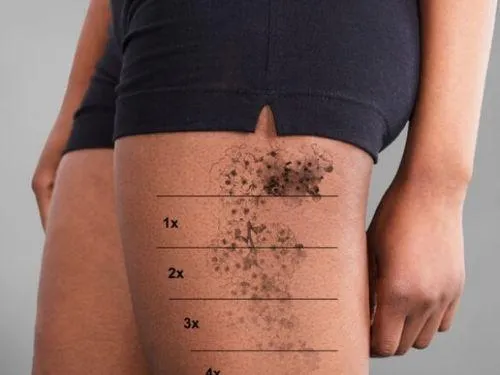Tattoo Removal: What to Know Before You Erase the Ink
Thinking of parting ways with your tattoo? Whether it was a spontaneous decision or no longer resonates with who you are, modern laser technology has made tattoo removal more approachable, effective, and safer. This comprehensive guide walks you through the essentials—how removal works, available techniques, potential risks, and what recovery entails.

Understanding Tattoo Removal: What It Is and How It Works
What Is Tattoo Removal?
Tattoo removal refers to the process of significantly fading or eliminating a tattoo from the skin. Although tattoos are intended to be permanent, today's laser innovations offer a safe and effective way to remove the ink from your skin.
Among the methods available, laser tattoo removal stands out as the most efficient. This treatment relies on intense pulses of light that break the ink into tiny particles, which are then gradually processed and flushed out by your immune system.
How Does Tattoo Removal Work?
The removal process works by directing specific light wavelengths into the skin, where the ink absorbs the energy. That energy shatters the ink into smaller bits, making it easier for the body to get rid of it over time.
There are two commonly used lasers:
Q-switched lasers: These have been a go-to solution for years when it comes to fading darker ink pigments. Because of their consistent results, these lasers have become a trusted option among many experienced tattoo removal specialists.
Picosecond lasers: These deliver extremely fast pulses of energy, allowing for more efficient treatment, especially on colorful or resistant tattoos.
Does Tattoo Removal Hurt?
Pain levels vary from person to person, but many compare the sensation to a snapping rubber band or short bursts of heat. Fortunately, most clinics offer numbing creams or localized anesthesia to ease the discomfort.
Who’s a Good Candidate for Tattoo Removal?
People who are in good physical health and have realistic expectations tend to respond best to tattoo removal treatments. Ideal candidates usually:
Avoid smoking or are willing to cut back during the treatment period
Have a healthy immune system
Are not currently pregnant or breastfeeding
Understand that results may differ depending on ink type, skin tone, and tattoo depth
Those with darker skin tones can still achieve good results, though working with an experienced provider is key to minimizing pigment changes or other complications.
Why Do People Get Tattoos Removed?
There are various personal and professional reasons behind tattoo removal:
Career considerations in industries with strict appearance policies
Changes in relationships, especially name tattoos
Tattoos that have faded or become distorted over time
A shift in personal identity or beliefs, where the tattoo no longer reflects who they are or what they stand for
Cover-up planning to replace an old design with a new one
Laser Tattoo Removal Explained: Process, Timeline, and Options
What Are the Different Tattoo Removal Methods?
Besides laser treatments, a few other options exist, though they tend to be more invasive or less reliable:
Surgical excision: This method involves a surgeon removing the area of skin where the tattoo is located. Once the tattooed
area is removed, the nearby skin is carefully stitched back together to close the wound. It’s typically used for small tattoos due to the potential for visible scarring. It’s typically reserved for small tattoos due to the possibility of scarring.
Dermabrasion: The outer layers of skin are physically sanded away. It can be painful and often leads to uneven results.
Tattoo removal creams: Widely sold online, these creams lack scientific backing and often cause more harm than good.
Laser Tattoo Removal Procedure: What to Expect
Initial consultation: You’ll meet with a trained specialist who will examine your tattoo and skin tone to create a tailored removal plan.
Preparation: The skin is cleaned, and numbing agents may be applied.
Treatment: A laser device is used to target the ink, with each pass breaking down more pigment.
Post-care: The area may be bandaged, and you’ll be given detailed aftercare instructions to follow.
Why Multiple Sessions Are Needed
Because tattoos are embedded in multiple layers of skin, removing them fully requires several sessions. Each session allows the ink to break down further, while giving your skin a chance to recover in between.
Several factors influence how many sessions you’ll need:
The type and shade of ink used (black tends to respond quickest, while greens and yellows are more stubborn)
How deeply the ink has been layered into the skin during application
The size, age, and location of the tattoo
Your body’s immune system and how well it heals
Most people need around 6 to 10 sessions, typically spaced 6 to 8 weeks apart, to give their skin enough time to recover and their body time to flush out the broken ink.
Will Laser Tattoo Removal Fully Erase My Tattoo?
In many cases, yes, especially for professional tattoos with dark ink. However, results vary based on the type of ink, depth, and your body’s ability to process ink particles. Occasionally, a faint shadow or ghost of the tattoo might remain.
Can You Remove a Tattoo at Home?
Though some products and remedies claim to remove tattoos at home, they often fall short and can cause serious harm. Over-the-counter creams and acids are not FDA-approved and may lead to burns, infections, or scarring.
DIY methods might seem convenient, but they are generally ineffective and risky. Always consult a trained professional to avoid unnecessary complications.
Finding the Best Laser Tattoo Removal Near You
Searching for laser tattoo removal near me? Here's how to pick a reputable clinic:
Look for a licensed dermatologist or technician with certification
Choose providers using advanced tools like picosecond lasers
Review before-and-after images
Ask about their experience with your specific skin tone and ink colors
Get a transparent quote and treatment plan
Quality counts more than low cost. Choose safety and experience over discounts.
How Long Does Tattoo Removal Take?
Aftercare and Healing: How to Protect Your Skin
Each session generally lasts between 15 and 45 minutes. The full course of treatment can take anywhere from six months to over a year, depending on how your body responds.
Post-Treatment Care Tips
Proper care after each session can speed up recovery and prevent side effects:
Gently clean the area and keep it dry
Apply a healing ointment (such as Aquaphor or what your provider recommends)
Avoid direct sunlight
Refrain from picking at scabs or peeling skin
Wear loose-fitting clothing
Avoid strenuous workouts until healed
Following these steps gives your skin the best chance to heal properly and limits side effects.
Is Tattoo Removal Safe? Weighing the Benefits and Risks
Benefits of Tattoo Removal
Clears skin for new tattoos or professional needs
Eliminates regret or emotional triggers
Helps restore confidence
Is Laser Tattoo Removal Safe?
Laser tattoo removal is considered safe when done by a trained specialist using FDA-approved technology. Choosing a qualified provider can make a big difference in both safety and results. Choosing the right provider can make a big difference in your safety and overall results. Working with a knowledgeable and experienced specialist helps minimize potential side effects and ensures you get the safest, most effective results possible. Most side effects are mild and short-term.
Risks and Side Effects to Know
While uncommon, here are some things to watch for:
Temporary redness, swelling, or blistering
Changes in skin tone (lightening or darkening)
Scabbing or texture changes
Scars are rare, but possible—especially if you don’t follow post-treatment care properly.
Does Tattoo Removal Cause Scars?
Scarring isn’t typical with professional laser removal, but it can happen if the skin is damaged during or after treatment. Carefully following aftercare instructions reduces your chances.
Tattoo Removal Timeline and Expectations
How Many Sessions to Remove a Tattoo?
The number of sessions depends on several key factors:
Tattoo age and ink quality
Size and placement on the body
Your skin tone and healing speed
Most patients require between 6 and 10 sessions, though some may need more or fewer depending on their unique situation.
Setting Expectations
Tattoo removal isn’t immediate. You’ll need time, patience, and consistency to achieve the best outcome. Work with your provider to set realistic expectations based on your skin and tattoo.
Final Thoughts
Deciding to remove a tattoo is a big step, but for many people, it offers relief, closure, and a chance to start fresh with their skin. With advanced options like picosecond laser tattoo removal, even multicolored tattoos are more removable than ever.
If you're exploring removal options, take your time researching providers and choose one with a strong track record. The right specialist can help you achieve clear skin safely and with confidence.
We want what’s best for you and your skin. Tell us your concerns and we’ll work with you to meet your goals. We have the technology and expertise to make beautiful things happen. Each journey begins with an introductory consultation. Schedule one today!
EXPLORE
FOLLOW US
SIGN UP TO RECEIVE SPECIALS >
Emmanuel Skinscience is a brand owned and operated by Skinscience PLLC.
© 2026 All Rights Reserved. Terms of Use and Privacy Policy
